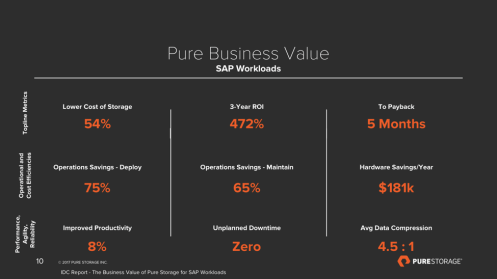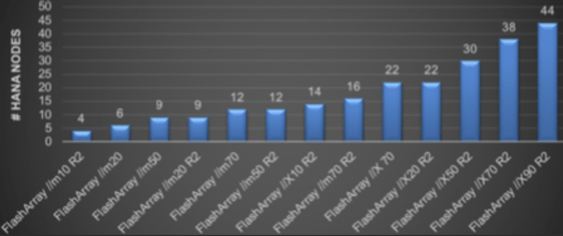The modern data center still hosts and runs a vast variety of mission critical applications, such as SAP, Oracle, and Microsoft SQL Server, amongst others. According to Hasso Plattner (SAP co-founder and chairman of the supervisory board) in last year’s SAPPHIRE keynote, it is expected that more than 65% of all mission critical workloads will stay on-premises, inside the customer data center. Businesses rely on these essential applications to provide the best performance, the lowest risk and highest availability, particularly when considering that the cost of downtime of a mission critical application can easily be more than $10,000 per minute.
The requirements on those mission critical OLTP database systems vary, but typically are 70% read and 30% write, sub-millisecond response time or latency, and — depending on the application (e.g. ERP, CRM, SCM etc.) — block sizes for the underlying infrastructure can vary between typically 4k blocks all the way up to 16M block sizes. In the past, it was quite tricky to configure and optimize infrastructure based on OLTP requirements, and so silos were built in order to meet the various performance requirements. But silos mean higher complexity, higher risk, and higher cost for organizations.
With Pure Storage®, traditional OLTP workloads, like mission critical ERP systems, do not need any special setup, configuration, or tuning requirements, and customers can run multiple OLTP workloads on the same array without building complex and costly silo hierarchies. Pure Storage FlashArray delivers flexible block sizes, efficient inline deduplication and compression, combined with initial installation and setup that Pure Storage customers say is ridiculously simple.
delivers flexible block sizes, efficient inline deduplication and compression, combined with initial installation and setup that Pure Storage customers say is ridiculously simple.
 With Pure Storage, customers can consolidate mission critical workloads onto the same array. Supporting mixed workloads on storage is no longer complex, nor does it require separate silos. For instance, customers can run traditional SAP with Oracle and SAP HANA on the same FlashArray, without any performance degradation, time consuming setup, or tuning. And it all comes included with value-added Pure Storage features, such as inline deduplication, compression, data reduction, quality of service (QoS), and Evergreen
With Pure Storage, customers can consolidate mission critical workloads onto the same array. Supporting mixed workloads on storage is no longer complex, nor does it require separate silos. For instance, customers can run traditional SAP with Oracle and SAP HANA on the same FlashArray, without any performance degradation, time consuming setup, or tuning. And it all comes included with value-added Pure Storage features, such as inline deduplication, compression, data reduction, quality of service (QoS), and Evergreen for non-disruptive upgrades and easy capacity expansion.
for non-disruptive upgrades and easy capacity expansion.
 In addition to offering massive simplification, Pure Storage arrays achieve unprecedented levels of OLTP performance, based on benchmarks. Running mission-critical OLTP workloads, such as SAP, can have a tremendous business value for customers. A recently published IDC paper revealed that customers running SAP on Pure Storage FlashArray can expect an average data compression ratio of 4.5:1, zero unplanned downtime, and reduced operations cost that can free up resources for more innovative projects.
In addition to offering massive simplification, Pure Storage arrays achieve unprecedented levels of OLTP performance, based on benchmarks. Running mission-critical OLTP workloads, such as SAP, can have a tremendous business value for customers. A recently published IDC paper revealed that customers running SAP on Pure Storage FlashArray can expect an average data compression ratio of 4.5:1, zero unplanned downtime, and reduced operations cost that can free up resources for more innovative projects.

Based on SAP HANA Certification: https://www.sap.com/dmc/exp/2014-09-02-hana-hardware/enEN/enterprise-storage.html#categories=certified%23Pure%20Storage%20Inc.
Looking at Pure performance delivered for SAP, we see that OLTP workloads have 30% better throughput and can provide over 1 million SAPS, which demonstrates that a large SAP landscape can run efficiently on a single storage array.
There is a good reason why Pure Storage’s //X arrays lead the industry when it comes to OLTP workloads. Performance, simplicity, scalability, flexibility, and workload consolidation make Pure Storage your best platform for mission critical workloads.
We are proud to have our work recognized, and that the Pure Storage M and X Series achieved the highest scores for the Online Transaction Processing use case in the 2018 Gartner Critical Capabilities for Solid State Arrays.

Source: Gartner Critical Capabilities for Solid-State Arrays, Valdis Filks, John Monroe, Joseph Unsworth, Santhosh Rao, 6 August, 2018.
This graphic was published by Gartner, Inc. as a part of a larger research document and should be evaluated in the context of the entire document. The Gartner document is available upon request from Pure Storage. Gartner does not endorse any vendor, product, or service depicted in its research publications, and does not advise technology users to select only those vendors with the highest ratings or other designation. Gartner research publications consist of the opinions of Gartner’s research organization and should not be construed as statements of fact. Gartner disclaims all warranties, expressed or implied, with respect to this research, including and warranties of merchantability or fitness for a particular purpose.




